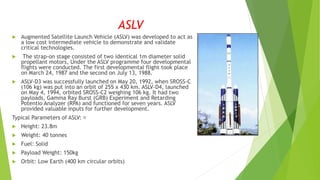The document provides an overview of the history and development of the Indian space programme. It discusses the key milestones and events, including the formation of INCOSPAR in 1962 and ISRO in 1969. It describes the early experiments with sounding rockets and the development of satellite launch vehicles. The document outlines the various centres and facilities of ISRO and lists some of the important satellites launched by India to date. It highlights the roles of pioneering scientists like Vikram Sarabhai and Satish Dhawan in establishing the Indian space programme.
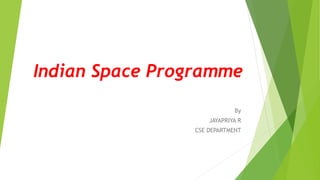


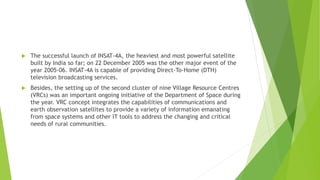











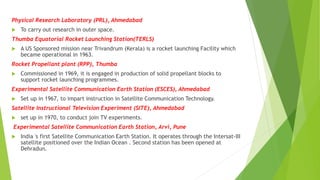
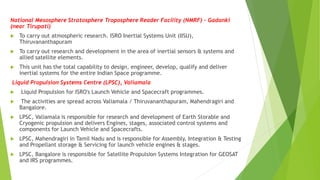
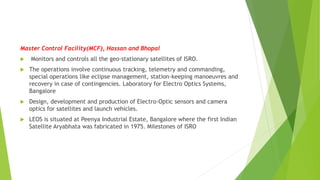

![Satellite
Launch
Date
Launch Launch
Type of Satellite
Vehicle site
Aryabhata 19.04.1975
Experimental / Small
C-1 Intercosmos Baikanur
Satellite
Bhaskara-I 07.06.1979
Earth Observation
C-1 Intercosmos Baikanur
Satellite
Rohini Technology
Payload (RTP)
10.08.1979
Experimental / Small
SLV-3 Sriharikota
Satellite
Rohini (RS-1) 18.07.1980
Experimental / Small
SLV-3 Sriharikota
Satellite
Rohini (RS-D1) 31.05.1981
Earth Observation
SLV-3 Sriharikota
Satellite
Ariane Passenger
Payload Experiment
(APPLE)
19.06.1981
Kourou (CSG), Ariane-1(V-3) Geo-Stationary Satellite
French
Guyana
Bhaskara-II 20.11.1981
Earth Observation
C-1 Intercosmos Baikanur
Satellite
INSAT-1A 10.04.1982
Delta 3910
Geo-Stationary Satellite America PAM-D
Rohini (RS-D2) 17.04.1983
Earth Observation
SLV-3 Sriharikota
Satellite
INSAT-1B 30.08.1983 Shuttle [PAM-D] Geo-Stationary Satellite America
Stretched Rohini
Satellite Series
(SROSS-1)
24.03.1987 ASLV Space Mission Sriharikota](https://image.slidesharecdn.com/indianspaceprogrammejpppt-221122101732-3733dd16/85/Indian-Space-Programme-JP-PPT-pptx-20-320.jpg)





